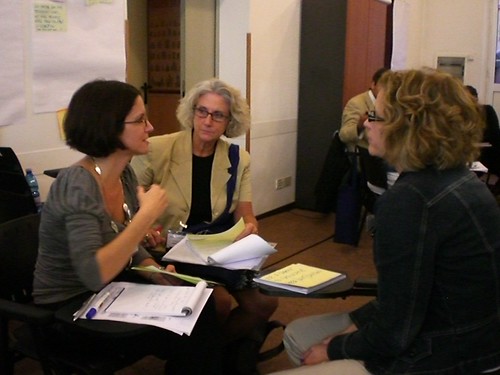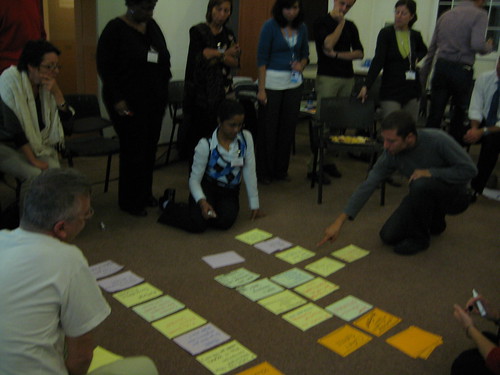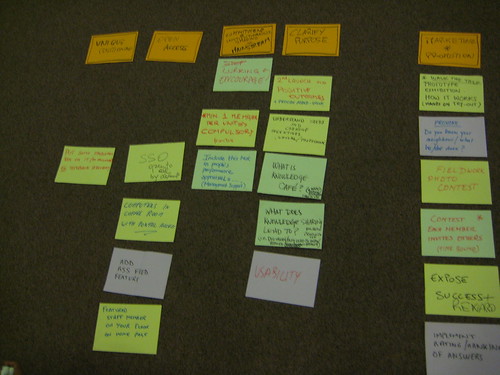The unique problem with this issue was that the intranet was accessible only to 6 of the participants in the workshop. For this very reason, getting the "right" method for this session was critical for its success. I decided to try out a brainstorming method! Here is how the session went:
Issue/Background
 The K-Café is a intranet Web site which offers a set of features and functions providing the best the virtual world can offer to optimize face-to-face and online interaction. The purpose of the K-Café is to provide a platform through which people can connect and share with each other their interests and ideas, in the spirit of knowledge sharing. Users can learn about colleagues who have a picture and profile, blog or comment on a posting within the Sharing in Action blog, ask a question, give an answer, and propose an event. The site also provides directory of knowledge sharing tools and methods.
The K-Café is a intranet Web site which offers a set of features and functions providing the best the virtual world can offer to optimize face-to-face and online interaction. The purpose of the K-Café is to provide a platform through which people can connect and share with each other their interests and ideas, in the spirit of knowledge sharing. Users can learn about colleagues who have a picture and profile, blog or comment on a posting within the Sharing in Action blog, ask a question, give an answer, and propose an event. The site also provides directory of knowledge sharing tools and methods.In terms of promotion, the site has been announced on the log-on page, the intranet as well as through divisional registries. A newsletter is sent out every week with all changes to the site (latest events, posts, members, etc.). The current statistics (eliminating the visits from those who manage the site) show that the site is visited approximately 1500 times a month.
The K-Café was launched in May 2009. Since then it has seen steady growth in participants (now up at 197). The Sharing in Action blog has been the most active component of the site. The question and answer section, which had as its aim to facilitate dialogue and discussion around issues and hurdles related to knowledge sharing has been slow in uptake.
We think the rate of adoption (in terms of profiles created, questions asked and answered, blog postings made/commented on, and connections with others who can provide relevant expertise) of the K-Café should be faster than at present. We want to see what we could do in order to increase the rate of update; bearing in mind the time we can devote to working on this is limited.
So, the key issue was framed as:
What will it take for a corporate tool such as the Knowledge Sharing Portal (K-Café) to encourage and cultivate knowledge sharing in an organization?Method Used
The method used for this session was a combination of the brainstorming method and card-sorting; it consisted of the following steps:
- The issue was introduced by giving demonstration of the intranet site as not everyone in the room (approximately 25 of 30 participants) knew about it.

- Everyone was asked to form groups of three or four and discuss ideas for addressing the above issue. Within these groups, the goal was to come up with 3-5 ideas that could help promote the use of the K-Café. The group was asked to write out each idea on a piece of paper (half A4).
- After approximately 10 minutes, once the groups had three to four ideas each, we formed a circle and each group was asked to give two or three of its best ideas to the facilitator.
 The facilitator then read out each idea and placed it on the floor in a horizontal row. If similar ideas emerged, they were placed in a column.
The facilitator then read out each idea and placed it on the floor in a horizontal row. If similar ideas emerged, they were placed in a column.- Once the first round of ideas were placed, the facilitator asked for another 2 or 3 ideas per group which were NOT yet mentioned. This way, the wide array of ideas were on floor in the center. The facilitator followed the same procedure as before (reading out the cards, asking the participants to group them, etc.)
- This was repeated until everyone had given their best ideas.
 The last step included looking at each column and finding the "action item" to group the ideas together (keeping the question in mind).
The last step included looking at each column and finding the "action item" to group the ideas together (keeping the question in mind).Results
For the K-Café to encourage and cultivate knowledge sharing in the organization, the following ideas emerged, amongst others:
1. Ensure unique positioning by putting some production tool on the K-Café that is unique, if not exclusive (i.e., a telephone directory)?
- make the Café unique by putting information there that one can not find anywhere else;
- a poll would also be useful to promote continuous interaction
- allow members to invite others
- do a 2nd launch emphasizing the positive effects the K-Café has had on the work of those who have used it, so far, as a way of evaluating and reframing the Café; expose the successes and the rewards
- explain how workload/productivity will decrease/increase and what’s in it for them
- enable a daily feature such as did you know that your colleague is doing this and this?
- include story-telling videos
- leverage Google analytics in order to see what parts of the K-Café are most visited, and when; this will help to better understand its usage and better target potential users
- ask those who use it whether they know their neighbours and what they do
- have a staff member of the month content feature
- organise a field work photo contest on the K-Cafe
- implement ranking of questions and answers
- organise hands-on introductory sessions
- organise more prototype exhibition sessions to show how the K-Café works and explain why people would find it useful if they use it
- Mainstream the use of the K-Café by ensuring at least one person from each department is a member, include membership of K-Café and its active use in performance appraisals, etc.
- use raffle prizes to stimulate activity
- reward behaviours you would like to see evolve and develop
- explain what prompted the existence of the K-Café on the first page
- ensure open access from anywhere in FAO (field, HQ) and in particular build in an RSS feature
What worked well:
- In general, the method was perceived as both fun and interactive, especially in its mix of small-group and larger-group work. Participants enjoyed both the small group work and the larger group work.
- The method process was interesting in that it allowed for collective thoughts and suggestions for action to emerge from the participants group.
- The method is great for digging out/flushing out ideas from the group.
- The facilitator did a very good job in organising and sorting the ideas, always ensuring the agreement and participation of the group. She also did a very good job in keeping the interest of all participants high and their attention poised on the task being tackled.
- The room set-up worked very well.
- Time was not enough to clearly formulate suggestions for action to each idea.
- In itself, the method process is intense in that it requires a lot of group thinking. At times, the group attention faded and the burden fell a little too much on the facilitator.
- Allow for more time to do the method with a short break in the middle.
- Work with pre-defined categories?
- Ask people to write their names next to each idea in order to help with the sorting process? (people can be asked to elaborate when ideas are not so clear)
No comments:
Post a Comment